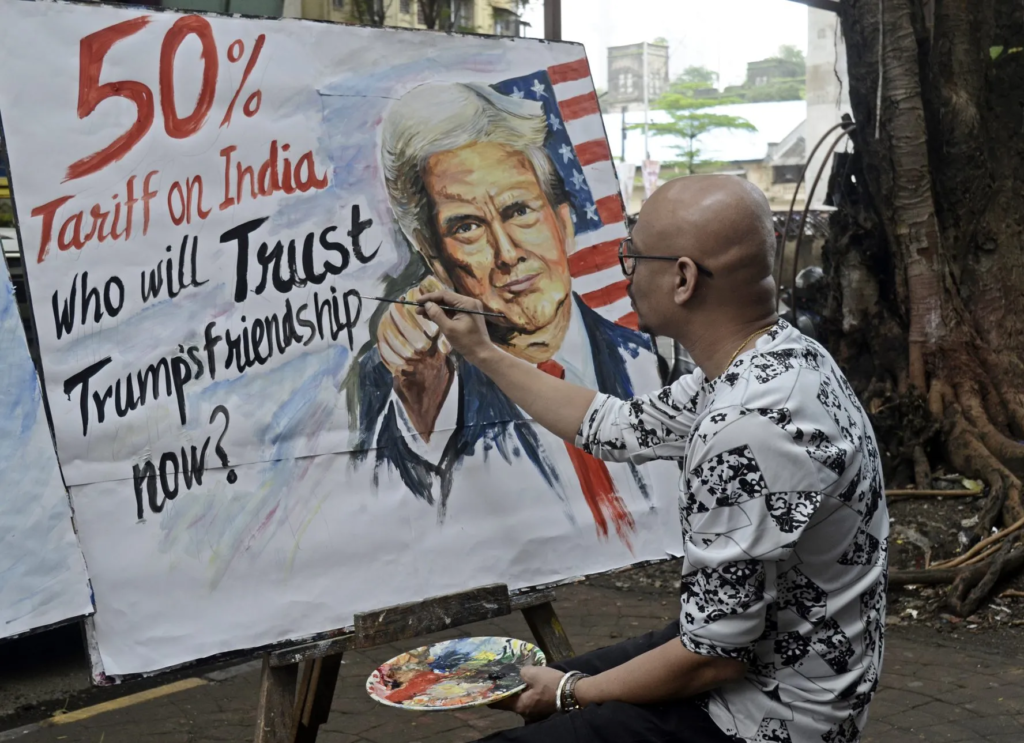Reassessing U.S.-India Relations: Challenges & Opportunities in a Changing Geopolitical Landscape
-
by nagendra singh
- 25

For two decades the India–United States relationship has been sold as a geopolitical win-win: a democratic partnership to balance China, booming trade, defence deals, and a mutual love for tech start-ups and lobbyists. But today that story is fraying. A new diplomatic and trade crisis has exposed deep differences in priorities and patience — and suggests Washington is in danger of losing influence in New Delhi unless it changes course. (Reuters, Brookings)
What happened (quick recap)
The flashpoint was trade and energy policy: the U.S. has moved to impose steep, punitive tariffs on Indian imports — part of a broader pressure campaign tied to India’s ongoing purchases of discounted Russian crude and longstanding defence-commercial ties with Moscow. New Delhi, which has leaned into cheap Russian oil to guard energy security and fiscal stability, pushed back, saying its purchases are matters of national interest. That standoff has rippled into diplomatic coolness, threats to defence cooperation and broader strategic coordination. (Reuters, Wikipedia)
Why India did what it did — and why Washington miscalculated
From New Delhi’s perspective the calculation was simple: energy is a first-order national need. After Russia’s invasion of Ukraine, western buyers reduced purchases and offered higher prices. India bought discounted seaborne crude to fuel growth and tame inflation — a rational economic move that also kept refineries humming. Washington framed that behaviour as indirectly propping up Moscow’s war economy; New Delhi framed U.S. demands as undue pressure on its sovereignty and strategic autonomy. The clash was therefore not only about commerce, but about who sets the rules. (CSIS, Reuters)
Washington, by contrast, appears to have adopted a transactional posture: bind partners with carrots and punish noncompliance with tariffs and public rebuke. That works when partners value the carrot more than the cost of autonomy. But India — which prizes “strategic autonomy” and has deep historical ties with Russia — may simply see the tariff stick as proof the U.S. treats the relationship as conditional rather than strategic. That’s politically damaging for bilateral trust. (Brookings)
Signs that America is losing influence in New Delhi
- Policy divergence on Russia and energy. India is openly buying Russian crude even as the U.S. calls it problematic. That divergence undercuts coordinated pressure on Moscow. (Reuters)
- Diplomatic coolness, not just rhetoric. Reports and analysis show deeper strains — from slowed negotiations to snappish public statements — that suggest the relationship’s emotional bank account is drained. (Brookings)
- Alternative partnerships matter. India still conducts large-scale defence and energy business with Russia and engages with China in trade and multilateral platforms. If the U.S. looks like an unreliable partner, New Delhi has other cards to play. (CSIS)
- Domestic politics and optics. Leaders in India can use perceived foreign pressure to rally domestic support for independence in foreign policy. The optics of an “adult” India making its own choices play well at home. (The Indian Express)
Put bluntly: when a partner publicly imposes pain (tariffs) and then signals impatience rather than partnership, the partner you want to influence may simply accept the pain and go its own way. That’s not weakness on India’s part; it’s a strategic bet that autonomy is more valuable than short-term market access.
The practical costs for the U.S.
Losing influence in Delhi isn’t just a blow to American prestige. It has measurable consequences:
- Security cooperation friction. Defence projects, logistics arrangements and intelligence sharing rely on trust. Tensions raise transaction costs and slow interoperability. (Reuters)
- Economic pain for American business. Trade fights invite retaliatory measures and make India a harder market for U.S. companies.
- Geostrategic risk. If India leans visibly toward Russia or further hedges with China, U.S. plans for an Indo-Pacific balance become harder to execute. (Financial Times)
What India gains (and why it refuses to blink)
India’s gains are clear: cheaper energy for industry and consumers, political room to manoeuvre, and the domestic narrative of standing up to external pressure. New Delhi also signals to other Global South states that alignment with Washington is not the only ticket to development. In short: India is recalibrating what it values most — sovereignty, growth, and multi-alignment — rather than subordinating those goals to a single ally.
How this could be fixed (a short diplomat’s playbook)
- Shift from public punishment to private diplomacy. Tariffs posture the U.S. as coercive. Quiet engagement that respects India’s domestic constraints would be more effective. (Brookings)
- Offer credible alternatives. If energy diversification is the ask, U.S. must provide tangible offers — LNG contracts, investment, technology — not just moralizing.
- Reframe security partnership as co-equal. Treat India as a strategic partner with its own priorities, not merely a junior partner whose choices are to be policed.
- Lock in collaboration on mutual interests. Climate, semiconductors, supply-chains and counterterrorism are areas where both can reap gains and build trust.
Also read :
Learn 80% of Perplexity AI in Under 5 Minutes
How Social Media Algorithms Influence Our Daily Lives
For two decades the India–United States relationship has been sold as a geopolitical win-win: a democratic partnership to balance China, booming trade, defence deals, and a mutual love for tech start-ups and lobbyists. But today that story is fraying. A new diplomatic and trade crisis has exposed deep differences in priorities and patience — and…
For two decades the India–United States relationship has been sold as a geopolitical win-win: a democratic partnership to balance China, booming trade, defence deals, and a mutual love for tech start-ups and lobbyists. But today that story is fraying. A new diplomatic and trade crisis has exposed deep differences in priorities and patience — and…